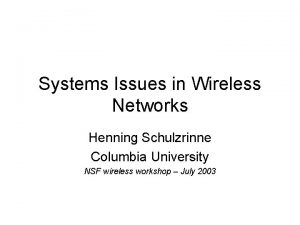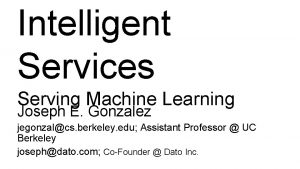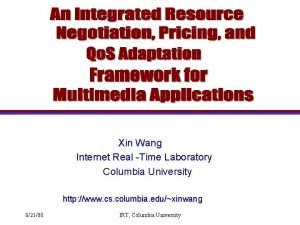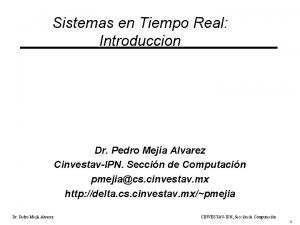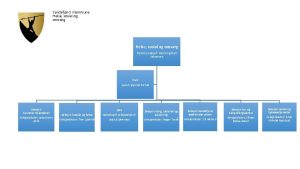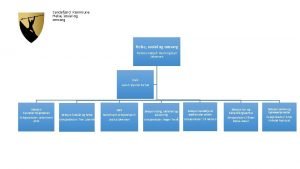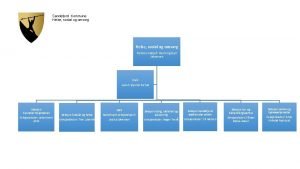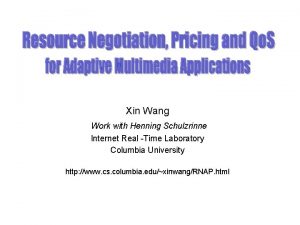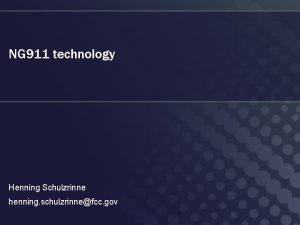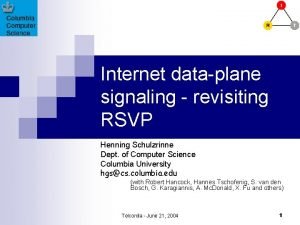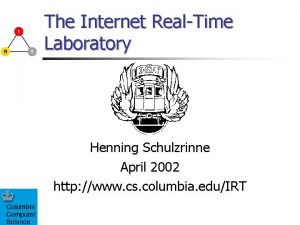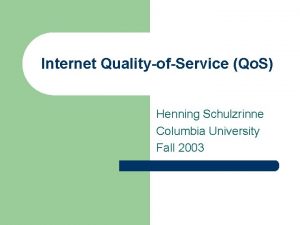Xin Wang With Henning Schulzrinne Internet Real Time













- Slides: 13

Xin Wang With Henning Schulzrinne Internet Real -Time Laboratory Columbia University http: //www. cs. columbia. edu/~xinwang/RNAP. html

Today’s IP Networks Service Level Agreements (SLA) are negotiated based on Application Specific Needs bandwidth, loss, delay, jitter, availability, price A pp lic ISP Networks & Applications Application SLA IP at io n SL A Network Service User SCOPE n n Growth of new IP services and applications with different bandwidth and quality of service requirements Presents opportunities and challenges for service providers 10/20/2021 2

The needs of Next Generation Service Providers n n Revenue from the traditional connectivity services (raw bandwidth) is declining Increase revenue by offering innovative IP services: u u Deliever high-margin, differentiated services Vo. IP, VPN, Applications Hosting etc n Gain competitive advantage by deploying new services more quickly, placing a premium on time to market and time to scale n Reduce cost and operation complexity u u 10/20/2021 Evolve from static network management to dynamic service provisioning Reduce costs by automating network and service management 3

Internet Structure End User Regional Provider NAP LAN POP Regional Provider Backbone Provider Private Peering Backbone Provider 10/20/2021 Private Peering Private Network 4

NORDUnet Traffic Analysis 10/20/2021 5

NORDUnet Traffic Analysis n Results: u All access links (interconnect ISP’s or connect private networks to ISP’s), including trans-Atlantic links, can get congested. u Average utilization is low: 20 -30% u Peak utilization can be high: up to 100% è Congestion Ratio (peak/average): as high as 5. u Peak duration can be very long: è Chicago NAP congested once in 8/00, lasted 7 hours. è Tele. Globe links congested every workday in 8/00 and 9/00 n Reasons: Frequent re-configuration and upgrading; Load balancing to protect own users. 10/20/2021 6

Solution - Over-provisioning? n n Add enough bandwidth for all applications in access network / backbone Will over-provisioning be sufficient to avoid congestion? u How much bandwidth is enough to meet diverse user requirements? u No intrinsic upper limit on bandwidth use n How much does it cost to add capacity? 10/20/2021 7

Bandwidth Pricing n Reality: leased bandwidth price has not been dropping consistently and dramatically. n Facts: u 300 mile T 1 price (rent): è 1987: $10, 000/month è 1992: $4, 000/month è 1998: $6, 000/month (thanks to high Internet demand) u 100 -mile cabling cost in 1998: $65, 000 n Links connecting ISP’s are very expensive 10/20/2021 8

Bandwidth Pricing (cont. ) n Facts: u International Frame Relay with 256 -kbps: thousands dollars a month. u Transit DS-3 link: $50, 000/month between carriers. u Transit OC-3 link: $150, 000/month between carriers. u Chicago NAP: è$3, 900/month/DS-3, è$4, 700/month/OC-3. Bandwidth may be cheap, but not free Higher-speed connection -- higher recurring monthly costs. Option - manage the existing bandwidth better, with a service model which uses bandwidth efficiently. 10/20/2021 9

Solution - Other Service Models n Quality of Service (Qo. S) u Condition the network to provide predictability to an application even during high user demand u Provide multiple levels of Qo. S to meet diverse user requirements u How efficient a Qo. S mechanism manages the bandwidth? How much a user needs to pay for Qo. S? n Application adaptation u Source rate adaptation based on network conditions can avoid congestion and lead to efficient bandwidth utilization u Why would an application adapt? 10/20/2021 10

A more Efficient Service Model n Dynamic resource negotiation u Network commits resources for short intervals - better response to changes in network conditions and user demand n Usage-, Qo. S-, demand-sensitive pricing u Allow network to price services based on resources consumed, and allocate resources based on user willingness -to-pay u Give user incentive to select appropriate service based on requirements, adapt demand during network resource scarce in response to price increase 10/20/2021 11

What We Add to Enable This Model? n A dynamic resource negotiation protocol: RNAP u u u u n An abstract Resource Negotiation And Pricing protocol Enables user and network (or two network domains) to dynamically negotiate multiple services with different Qo. S characteristics Enables network to formulate and communicate prices and charges Lightweight and flexible: embedded in other protocols, e. g. , RSVP, or implemented independently Ensures service predictability: commit service and price for an interval Supports multi-party negotiation: senders, receivers, or both Reliable and scalable A demand-sensitive pricing model u u 10/20/2021 Enables differential charging for supporting multiple levels of services; services priced to reflect the cost and long-term user demand Allows for congestion pricing to motivate user adaptation 12

What we add. . . (cont’d) n n Demonstrate a complete resource negotiation framework (RNAP, pricing model, user adaptation) on test-bed network Simulations show significant advantages relative to static resource allocation and fixed pricing: u Much lower service blocking rate under resource contention u Service assurances under large or bursty offered loads, without high provision complexity, or over-provision cost u Higher perceived user benefit and higher network revenue 10/20/2021 13
 Henning schulzrinne
Henning schulzrinne Xin wang uc berkeley
Xin wang uc berkeley Xin wang columbia law
Xin wang columbia law Sensor and (tiempo real or real time)
Sensor and (tiempo real or real time) Entanglement
Entanglement Brad henning
Brad henning Henning fjell johansen familie
Henning fjell johansen familie Kriminalgeschichte des christentums gesamtausgabe
Kriminalgeschichte des christentums gesamtausgabe Henning kurz
Henning kurz Sandefjord kommune organisasjonskart
Sandefjord kommune organisasjonskart Elise henning
Elise henning Matthias henning
Matthias henning Tine luberth
Tine luberth Henning kurz
Henning kurz
